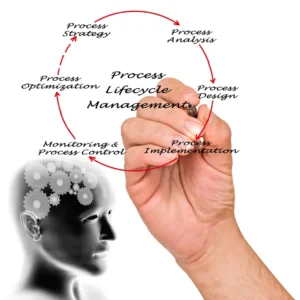
Strategic Decisions
Selecting the Right AI Tools for Your Business Success
In the fast-paced landscape of modern business, leveraging Artificial Intelligence (AI) has evolved from a competitive advantage to a strategic necessity.
The journey towards AI integration begins with the critical task of selecting the right tools, which demands meticulous consideration and informed decision-making. The success of AI implementation hinges on aligning technological capabilities with specific business objectives and challenges.
When choosing the right AI tools for your business, it’s essential to consider a few key factors. This article is aimed at business leaders and technical solution providers and highlights critical aspects to consider. The text is organized logically, with the most essential information presented first.
From understanding internal capabilities to evaluating vendor reputations, ensuring data security, and navigating legal considerations, each step contributes to the foundational decisions that will shape the trajectory of AI integration.
Join us in exploring the nuanced aspects of this transformative journey, where the strategic selection of AI tools becomes a cornerstone for sustainable growth and operational excellence.
Define Business Objectives
Defining clear business objectives is paramount in the pursuit of efficiency and growth. Begin by outlining your goals and identifying areas where AI can bring tangible value. Pinpoint specific challenges or problems that hinder your business performance; this clarity is pivotal.
Understanding the nuances of your business objectives lays the foundation for effective AI integration. Whether streamlining processes, enhancing customer experiences, or optimizing resource allocation, align AI applications with your unique needs.
By recognizing the intricacies of your challenges, you empower AI to be a tailored solution. Whether improving operational workflows, analyzing vast datasets, or predicting market trends, a targeted approach ensures that AI becomes a strategic asset.
Remember, the synergy between business objectives and AI applications is not just about adopting technology; it’s about achieving meaningful outcomes. Clearly defined goals and a nuanced understanding of challenges will guide you in selecting AI tools that genuinely align with and elevate your business.
Assess Internal Capabilities
When embarking on the AI journey, introspection is critical. Start by evaluating your team’s proficiency in AI and its related technologies. Assessing the level of expertise of the team members involved is essential to integrate AI tools. This assessment will help determine the appropriate foundation for effectively integrating the AI tools.
Should gaps in AI knowledge exist, consider the necessity for additional training. Investing in upskilling your existing team can enhance internal capabilities, ensuring a smoother integration process. Evaluate if this augmentation suffices or if the complexity of AI tasks warrants the recruitment of specialized talents.
Understanding your team’s AI competency is not just about the present; it’s a forward-looking approach. It’s about aligning internal capabilities with the evolving landscape of AI technology.
This assessment enables a strategic approach to selecting AI tools that complement and leverage your team’s strengths, fostering a harmonious blend of human intelligence and artificial capabilities. By ensuring that your internal capabilities align with the demands of AI integration, you lay a robust foundation for successfully deploying advanced tools in your business landscape.
Understand AI Tools
It is crucial to understand AI tools to improve efficiency and drive innovation. Research various tools like machine learning, natural language processing, and computer vision to make informed decisions.
Identify tools that resonate with your business goals. Whether enhancing customer experiences or optimizing operational processes, align AI tools with your unique objectives. Furthermore, consider the technical aspects — ensure the chosen tools seamlessly integrate with your existing infrastructure.
This process of understanding and alignment transforms AI from a mere technology into a strategic asset. By choosing tools that resonate with your business goals and technical prerequisites, you pave the way for a synergistic relationship between your business objectives and the capabilities of advanced AI tools. This deliberate selection ensures that the integration of AI becomes a purposeful step towards achieving your organization’s broader goals.
Consider Customization
In pursuing optimal AI integration, the consideration of customization plays a pivotal role. Begin by assessing whether off-the-shelf solutions suffice for your business requirements or if a bespoke approach is necessary.
Customization is not a luxury but a strategic necessity. Tailoring AI solutions to specific business needs ensures they become a seamless extension of your operations. This personalized touch is more than an enhancement; it’s a competitive edge, enabling your business to address unique challenges effectively and stand out in the market.
Off-the-shelf solutions may offer generic benefits, but the power lies in adaptability. Custom AI solutions mould themselves to the contours of your business, aligning intricately with your processes and goals. This tailored approach ensures that AI is not a detached technology but an integrated force, propelling your company towards unparalleled efficiency and success. By understanding the need for customization, you position your business to harness the full potential of AI, making it a catalyst for growth rather than a mere technological addition.
Evaluate Vendor Reputation
Carefully scrutinizing vendor reputation is a linchpin in the journey to optimal AI integration. Begin by thorough research, delving into potential AI vendors’ reputations and track records.
Reliability is paramount. Ensure the selected vendor has a history of dependable service and support. Evaluate their track record with successful AI implementations, particularly in industries similar to yours.
Consider vendor support as a critical component. A reliable partner assists when needed, ensuring a smooth integration process. Successful implementations in comparable industries testify to the vendor’s ability to adapt solutions to diverse business landscapes.
Choosing an AI vendor is not just a transaction; it’s a partnership. The vendor’s reputation and past performance are indicators of future reliability. This meticulous evaluation safeguards your business against potential pitfalls, ensuring that the selected AI tools come from a trustworthy source, setting the stage for a successful and enduring collaboration.
Scalability and Flexibility
In the pursuit of seamless integration, scalability and flexibility emerge as cornerstones for selecting AI tools.
Scalability is not just a feature; it’s a necessity. Ensure the chosen AI tools can grow with your business. A solution that adapts to increasing demands ensures a sustainable investment.
Flexibility is the key to resilience. Assess how well AI solutions can adapt to changing business requirements. An agile solution aligns with your evolving needs, preventing the tools from becoming obsolete in the face of dynamic challenges.
The scalability and flexibility of AI tools are not mere checkboxes; they dictate the longevity of your investment. Choosing tools that scale and adapt positions your business to thrive amidst growth and change, ensuring that AI remains an asset, not a constraint, in your evolving business landscape.
Integration with Existing Systems
Harmonious integration with existing systems is pivotal in selecting AI tools for your business.
Assess the synergy: How well do the AI tools integrate with your current systems and infrastructure? Compatibility ensures a smooth assimilation, avoiding operational hiccups.
Choose wisely to minimize disruptions. Opt for AI tools that seamlessly align with your established technology stack. This strategic selection safeguards against the complexities of overhaul, ensuring a streamlined integration process.
The compatibility of AI tools with existing systems is more than just a technical detail; it is a strategic consideration. It determines the ease of implementation and the efficiency of your overall operations. By prioritizing seamless integration, you position your business for a technology-driven transformation that complements, rather than disrupts, your existing workflows.
Data Security and Compliance
In the digital age, prioritizing data security and compliance is non-negotiable when selecting AI tools for your business.
Make adherence paramount. Prioritize data security by aligning AI tools with industry regulations. A commitment to compliance safeguards against legal ramifications and fosters trust.
Choose AI tools that protect sensitive information and improve operations while maintaining privacy standards. This dual focus on functionality and security establishes a robust foundation for your AI integration.
In the realm of data-driven advancements, trust is the currency. By prioritizing data security and compliance, you mitigate risks and build a resilient framework for the ethical and secure utilization of AI tools in your business. This strategic approach ensures that your technological evolution aligns seamlessly with ethical standards and regulatory requirements.
Cost-Benefit Analysis
Prudent decision-making in AI adoption hinges on a meticulous cost-benefit analysis, spanning short-term gains to long-term sustenance.
Conduct a comprehensive evaluation. A thorough cost-benefit analysis unveils the ROI potential of AI solutions. Scrutinize financial implications for an informed decision.
Consider the holistic expense. Factor in not only initial costs but also ongoing maintenance and training expenditures. A balanced perspective ensures sustainable financial viability and operational efficiency.
In the calculus of technology integration, foresight is currency. By rigorously assessing costs and benefits, you ensure that AI tools align with your financial strategy, delivering immediate gains and enduring value throughout your business journey. This approach positions your business for a reasonable and sustainable AI implementation, optimizing returns while mitigating financial risks.
Pilot Programs
Before full-scale integration, pilot programs emerge as a strategic precursor, essential for refining AI tools effectively.
Commence strategically. Initiate pilot programs to evaluate AI tools in real-world scenarios. Practical tests unveil nuances critical for informed decisions.
Harness the power of feedback. The insights garnered from pilot programs are invaluable. Use this feedback to fine-tune and optimize the chosen solutions. The iterative process ensures a tailored fit.
Pilot programs are not mere trial runs but strategic gateways to success. By gauging real-world efficacy and refining solutions based on feedback, you mitigate risks and maximize the potential of your chosen AI tools. AI integration should align perfectly with your business goals.
Continuous Evaluation and Improvement
Sustainable AI integration hinges on continuous evaluation, shaping a perpetual enhancement and refinement roadmap.
Establish rigorous mechanisms. Constantly evaluate AI performance, ensuring it aligns with evolving business objectives. This ongoing scrutiny is the bedrock of success.
Implement feedback loops. Construct a systematic process to gather insights. Utilize feedback to refine and enhance AI models progressively. The iterative approach ensures that AI continuously evolves to meet dynamic business needs.
Continuous evaluation and improvement are not merely checkpoints but strategic imperatives. By fostering a culture of perpetual enhancement, you ensure that your AI tools remain effective, efficient, and aligned with the ever-evolving landscape of business demands. This commitment to refinement positions your business on a trajectory of sustained success in AI integration.
Training and Support
The bedrock of successful AI integration lies in robust training and support mechanisms, which are fundamental for user adoption and success.
Prioritize vendor support. Ensure selected vendors offer comprehensive training, empowering your team with the necessary skills for effective AI utilization.
Support fuels success. A well-supported AI implementation transcends technology. It cultivates a user-friendly environment, propelling adoption and ensuring the tools become catalysts for operational triumphs.
Training and support are not mere components; they are catalysts for success. By prioritizing vendor commitment to equipping your team, you fortify your business for a seamless AI integration journey. This strategic emphasis on training and support transforms AI from a technical addition into a transformative force that your team embraces, ensuring implementation success and sustained operational excellence.
Future-Proofing
Future-proofing your AI strategy requires a dual focus on visionary tools and forward-thinking vendors.
Choose foresight. Opt for AI tools and vendors committed to staying at the forefront of technology. This commitment ensures sustained relevance in a rapidly advancing landscape.
Adaptability is key. Aim for solutions capable of flexibly embracing emerging trends and advancements in AI. Future-proofing safeguards your investment, ensuring longevity in the face of technological evolution.
In the quest for AI tools, it’s not just about the present; it’s about building a future-ready foundation. By selecting tools and vendors committed to innovation, you ensure that your business remains at the forefront of technological advancements, staying agile in the face of dynamic industry changes. This strategic foresight is the linchpin for a successful and enduring AI integration that aligns seamlessly with the evolving needs of your business.
Legal Considerations
Navigating legal considerations in AI integration requires a proactive approach to safeguard your business interests.
Review comprehensively. Understand the legal aspects, encompassing intellectual property rights and liability issues associated with AI technologies.
Engage legal experts. Collaborate with professionals well-versed in AI legalities. Their insights are invaluable for navigating complexities, mitigating risks, and ensuring a compliant AI integration.
Legal considerations are not just checkboxes; they’re safeguards for your business. You fortify your AI integration against potential pitfalls by thoroughly reviewing and engaging legal expertise, ensuring a secure and legally sound foundation. This strategic approach positions your business for success, allowing AI to be a transformative force within the bounds of legal and ethical standards.
User-Friendly Interface
User-friendly interfaces are pivotal. Simplicity becomes a strategic advantage when choosing AI tools, especially for non-technical staff.
Prioritize accessibility. Consider the user-friendliness of AI tools, ensuring they align with the proficiency of non-technical users.
Unlock adoption. An intuitive interface becomes the bridge to success. Enhance user adoption by selecting tools that simplify complex processes.
In the realm of AI integration, accessibility matters. By prioritizing user-friendly interfaces, you ease the learning curve for non-technical staff and ensure that AI tools become seamlessly integrated into your business operations. This strategic emphasis on simplicity transforms AI from a potential source of complexity into a tool that enhances user engagement, driving overall success in your technological endeavours.
Table of Contents

Arindam Roy
An Automation Consultant with 25+ years of IT Experience
Related Articles
- Training and Upskilling for AI-Enabled Workforce for IPA
- Challenges in Successful Implementations of AI Tools for IPA
- Addressing Security Concerns in AI-Driven Process Automation
- Integrating AI Tools with Existing Systems for IPA
- Selecting the Right AI Tools for Your Business
- Key Features of AI Tools for IPA: Transforming Processes
- AI Tools for IPA: Revolutionizing Business Efficiency
- Benefits of Implementing AI Tools for IPA
- Understanding the Business Context of IPA
- Evolution of AI in IPA: From Rules to Industry 4.0
Conclusion
Choosing the perfect AI tools for your business can be a game-changer in today’s fast-paced technological world. So, buckle up and let’s explore how to select the right AI tools that can help you achieve your business goals. The journey begins by defining business objectives and identifying areas where AI can deliver tangible value. Understanding specific challenges and opportunities lays the foundation for strategic decision-making.
Researching and comprehending various AI tools aligned with business goals and technical requirements is pivotal. Customization, scalability, and flexibility become crucial considerations when tailoring AI solutions to unique business needs.
Vendor reputation evaluation ensures reliability, support, and successful implementations in similar industries. Factors like data security, compliance, and legal considerations safeguard against potential risks. A meticulous cost-benefit analysis paves the way for informed financial decisions.
The emphasis on continuous evaluation, training, and support ensures that AI becomes an organic part of daily operations. Future-proofing guarantees sustained relevance through tools and vendors committed to technological advancement.
In the grand orchestration of AI integration, user-friendly interfaces and pilot programs become harmonious notes. Finally, the strategic selection of AI tools positions your business for a transformative journey, where technology becomes not just a solution but a catalyst for lasting success. Selecting the right AI tools is not a one-time decision; it’s an ongoing commitment to the evolution and prosperity of your business.






















